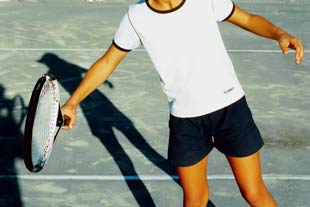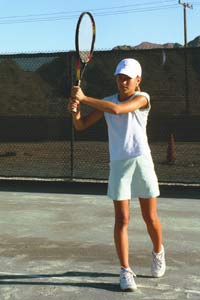Secrets of a True Master:
Balance
Welby Van HornPage 2
 |
The weight transfer raises the back hip, and is most pronounced on the one-handed backhand. |
Rotation
After the step forward is made with the front anchor foot, the forward rotation of the hips and shoulders starts at the same time that the racket swings forward. On the forehand and two-handed backhand, the hips rotate forward (from the sideways position) 45 degrees by the time contact is made with the ball.
At the contact on these strokes, your belly button is more or less pointing to the point of contact. The hips continue to rotate after contact and at the end of the swing the hips face the net with the result that the hips have rotated back a full 90 degrees. On the forehand, the shoulders rotate slightly more than the hips by the end of the swing.
The rotation of the hips and shoulders on the one-handed backhand is not so great because the swing is away from the body.
Key Role Of The Adjustment Foot In Rotaion
On the groundstrokes the backfoot is the "Adjustment Foot." The adjustment foot allows the adjustment, or the rotation of the body, while keeping the body in balance.
The adjustment foot makes two movements on both the forehand and backhand. First, the adjustment foot pivots/turns so that at the end of the stroke the sole of the foot points to the back fence.
Second, the heel of the adjustment foot rises. The action is one of turning and rising. The adjustment foot begins with the heel on the ground and parallel to the back fence. It finishes on its toes and turned towards the back fence. The rising action complements the low to high swing pattern on the groundstrokes.
On the forehand, the adjustment foot makes a third movement. Specifically, during the turning and rising actions the foot also momentarily comes off the ground (but does not drag on the court) and moves slightly sideways to the right.
At the end of the movement, the back adjustment foot will be slightly closer to the right sideline (the left sideline in the case of a left-handed forehand) than the front anchor foot is. This third movement helps to rotate the hips on the forehand.
Using the mirror is a great way to check this third adjustment movement. If the back foot properly makes this adjustment, you will be able to see slightly between your knees at the finish of the forehand balance. I call this finish at the end of the forehand balance the "Modified Square Stance."
An extra racket can be placed on the ground to help the student learn this sideways movement. The student is told to finish the rotation/stroke with the toes of the back adjustment foot finishing in the middle of the strings of that racket.
The racket helps teach the student to accomplish the third movement by slightly lifting the foot off the ground and then placing it on the racket – if the student incorrectly attempts to accomplish the movement by dragging the foot on the ground, the student will hit the racket frame and push the racket away from her.
 |
At the finish on the groundstrokes you should be erect with the knees only slightly flexed. |
The Finish Position on the Groundstrokes
At the finish, the body should be fairly erect with the knees just slightly bent. This may come as a surprise as you will often hear the tennis tip to "keep your knees bent and stay low" at all times when you are moving to and striking the ball.
I do not agree. It is true that you want to bend your knees to get down to low balls. (Also, when you run hard your knees will bend a reasonable amount.) However, at the completion of the groundstrokes (even on the low shots) you should finish in a fairly erect position.
This fairly erect finish position complements the low to high swing pattern on the groundstrokes. When you finish in this position, you should feel that you can comfortably inhale and exhale a deep breath.
Take note that while you want to finish fairly erect, your knees should be slightly bent at the finish. It is important to avoid finishing with stiff knees - keep them a little bent. It is interesting to note that even at the very advanced levels when players jump off the ground on their groundstrokes, they still generally keep their knees a little flexed when in the air and when they land.
By landing with the knees a little flexed they are better able to push off the ground as they recover for the next shot. Lleyton Hewiitt is a great example of a player who lands with his knees a little flexed after he has jumped off the ground. Of course, this jumping technique is an advanced skill - beginners and intermediates should not focus on it.
Adjusting
If tennis was like golf or hitting a baseball, you would always set yourself up in the ideal balance position. But in tennis you have to move to the ball and this sometimes results in players not being in the ideal balance position. In other words, the practicalities of play, particularly as the pace of play accelerates, make it impossible to always assume the ideal positions.
Two more "adjustments" can help you convert certain less than ideal positions to the ideal balance finish position.
Sometimes a player will find himself in a closed stance, which prevents the hips from fully rotating. The adjustment is to move the backfoot sideways during the hit to convert the stance from a closed stance to the modified Square Stance discussed above. This adjustment is actually an exaggerated form of the normal "third movement" on the forehand balance.
The second additional adjustment applies to both the forehand and backhand groundstrokes. After the step forward with the anchor foot, the feet should be slightly more than shoulder width apart. But what if the step is larger (perhaps as a result of the player reaching forward for a low ball) so that the feet are farther apart than this ideal position? The player can put herself back in the ideal position by taking a forward adjusting step with the back foot so that the feet are now just slightly more than shoulder width apart.
The Head
Today, the critical importance of keeping a steady head as you stroke the ball is recognized by knowledgeable tennis teachers. It has always been an important part of my system.
In golf, it is very important to keep your head steady during the swing. I think this reminder is equally significant in tennis. I feel that keeping the head steady is an asset in watching the ball. To get the proper feeling of keeping your head steady, imagine that you have a glass of water on top of your head as you swing slowly, and try not to spill the water.
Certainly, you must move your head to watch the ball go back and forth from your opponent's racket to yours. But it is often a sideways thrust of the head towards the ball which prevents many players from watching the ball. By not controlling your head during your swing, you divert your eyes from the ball and destroy your timing.
This thrust of the head near the moment of impact with the ball is also the main reason why beginners get too close to the ball and hit it off-center. Try keeping you head steady on the groundstrokes, and I think you will be amazed at the results; you will find yourself hitting a majority of the balls in the center of the strings.
The Significant Other Arm and Hand
The non-racket arm and its hand play an important role in his tennis balance on the forehand and one-handed backhand groundstrokes, so much so that I call them: "The significant other arm and hand. "
On the forehand, the significant arm and hand point towards the on-coming ball as it approaches. This helps the player measure the distance of the approaching ball. When the hips start to rotate to the as part of the forward swing, the significant other arm and hand similarly rotate to the left. The significant other arm and hand stop rotating when the hand is to the left side of the body.
On the one-handed backhand, the significant other arm and hand have several roles. In the ready position, the fingertips of the significant other hand should hold the throat of the racket.
Don't grab the racket with the palm and make a fist around it. By using the fingertips, you can better control the racket face better, making it easier to change grips.
Next, the arm and hand help take the racket back on the backswing. At the end of the backswing, they "cradle" the racket.
On the forward swing, the significant other arm and hand then go backwards somewhat towards the back fence. This backwards movement serves as a counterbalance to the forward swing of the racket arm. At the finish of the one-handed backhand groundstroke, the player is much like a tightrope walker with his arms held out in opposite directions to aid in his balance.
So that's a good general description, but in my system I get even more specific. If you've come this far, let's take it all the way in the next article and build the fundamentals of balance into your strokes for life. Warning: you'll need discipline but it's worth it.




